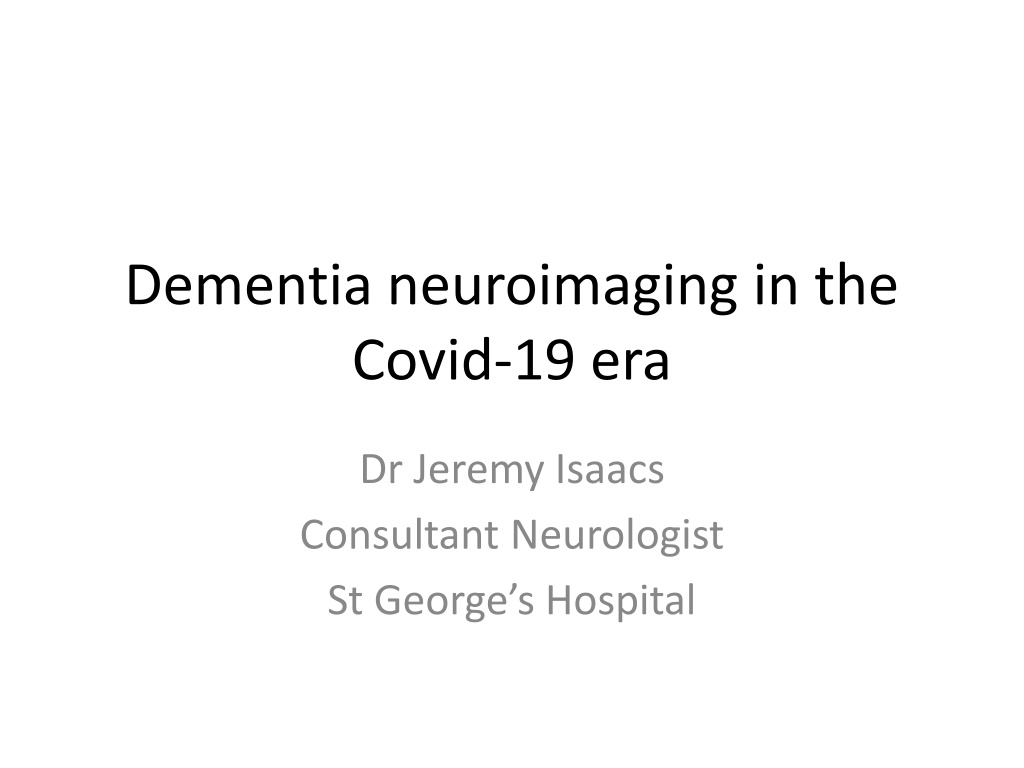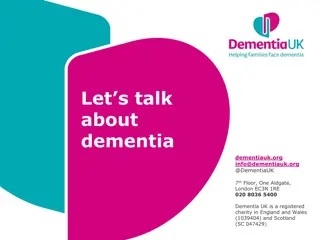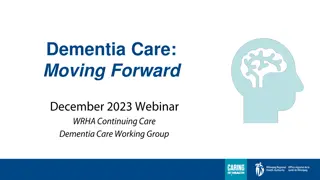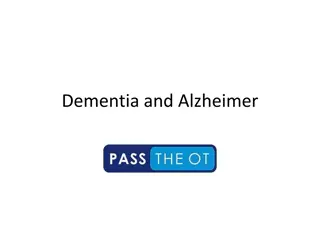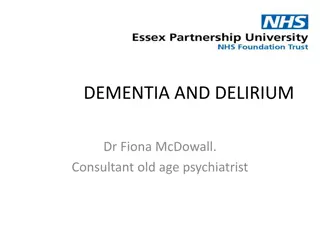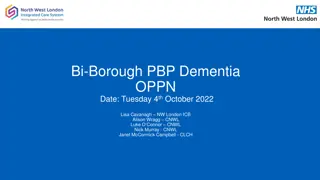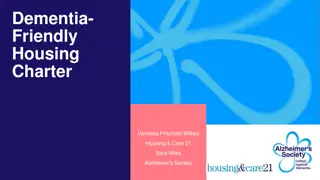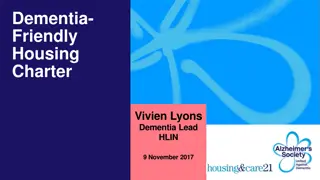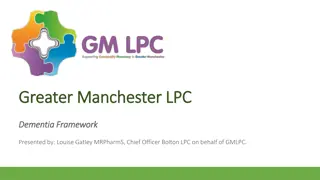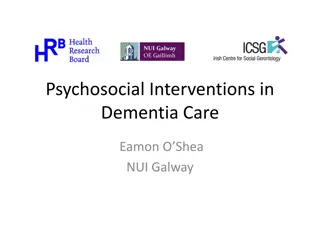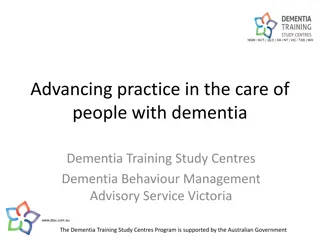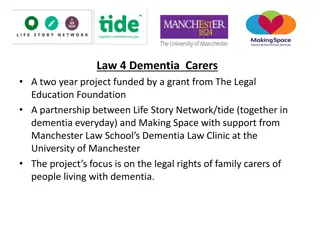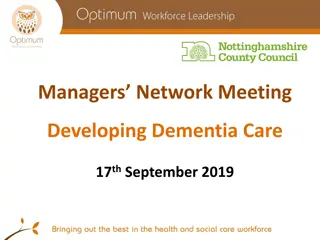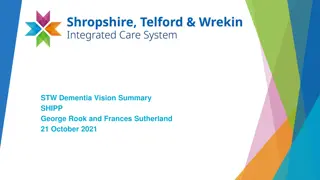Dementia Neuroimaging in the Covid-19 Era
In the Covid-19 new normal, challenges arise in dementia neuroimaging, leading to longer waiting times for scans and the need for peer-to-peer discussions to reduce clinical uncertainty. A pilot project in London showcases the importance of multidisciplinary team meetings to improve diagnosis and change previous diagnoses effectively.
Download Presentation

Please find below an Image/Link to download the presentation.
The content on the website is provided AS IS for your information and personal use only. It may not be sold, licensed, or shared on other websites without obtaining consent from the author. Download presentation by click this link. If you encounter any issues during the download, it is possible that the publisher has removed the file from their server.
E N D
Presentation Transcript
Dementia neuroimaging in the Covid-19 era Dr Jeremy Isaacs Consultant Neurologist St George s Hospital
The Covid-19 new normal Reduced diagnostic capacity across the NHS Need to minimise non-essential travel and contact, especially for medically vulnerable people and healthcare workers Discretionary medical activity should be scrutinised to ensure it adds true value Maximum use of already available information
What this means in practice Longer waiting times for scans Is there previous imaging to review? Can imaging be avoided altogether in some cases? Can a diagnosis be made prior to imaging? Can we reduce clinical uncertainty through (virtual) peer-to-peer discussion?
NHS London Dementia Clinical Network/SWL STP MDT project Pilot of bimonthly MDT with memory services, neuroradiology and cognitive neurology 42 patients discussed during four 90 minute meetings Average no. cases presented per meeting 11 (5-16) 88% of cases were presented by a memory service 21% of cases discussed were under the age of 65 In 95% the presenting clinician had a query about the diagnosis In 88% the clinician wanted to establish if neuroimaging findings supported the clinical impression
Results In 47% of cases, all three professionals (neurologist, neuroradiologist and memory service psychiatrist/nurse) were involved in the discussion In 50% of cases, discussion led to a firm diagnosis being made where the clinician had not achieved a final diagnosis 10 Alzheimer s disease, 4 FTD and 2 vascular dementia, 1 MCI, 4 non-dementia In a further 7% of cases the previous diagnosis was changed: One from Alzheimer s disease to vascular One from non-dementia to frontotemporal dementia One from dementia unspecified to Alzheimer s disease
Results In two cases the scan had been reported normal; on review it was abnormal and supported a dementia diagnosis In two cases an unnecessary MRI scan was avoided In two cases it was concluded that an MRI was required (where the patient had already had a CT scan) In one case the patient was referred for CSF examination In four cases discussion facilitated a referral to neurology In one case genetic testing was discussed and deemed not appropriate In two cases patients were going to be considered for a clinical trial following the discussion
https://www.england.nhs.uk/london/wp- content/uploads/sites/8/2019/09/SWL- Dementia-Multidisciplinary-Meeting- Project.pdf
What does NICE say about brain imaging in dementia? Offer structural imaging to rule out reversible causes of cognitive decline and to assist with subtype diagnosis Unless dementia is well established and the subtype is clear NICE does not specify whether CT or MRI is preferred except in suspected vascular dementia
How often does brain imaging demonstrate a reversible cause of dementia? How good is brain imaging at confirming the sub-type? What does well established dementia mean? When in the diagnostic process is brain imaging needed?
Neuroimaging isnt performed in the diagnosis of all brain disease Parkinson s disease Tic disorders Migraine Mild head injury Functional neurological disorders Most psychiatric disorders
Why dont we do imaging in Parkinson s disease? Classical Parkinson s phenotype is due to degeneration of nigrostriatal dopaminergic neurons This has no correlate on standard CT or MRI So no rule in value Equally, other pathologies don t generate the classical features of PD So no necessity to rule out other diseases
Can we transfer this to dementia? Rapidly progressive dementia Hard to justify not scanning to rule out CJD, glioma, lymphoma, hydrocephalus Atypical presentations that could be caused by focal structural pathology Expressive dysphasia with right-sided visual neglect
Progressive frontal lobe disorders Potentially could be caused by slow-growing tumour e.g. meningioma If patient is fit enough for surgery or other oncological treatment they should be scanned Urgency depends on speed of progression
What problems arise if diagnosis of bvFTD is delayed? Social ramifications of frontal lobe disorders are similar whatever the cause However, bvFTD is often a genetic disorder Mutations such as C9orf72 present in 5-20% of patients depending on extent of family history Genetic testing should be discussed with all patients with bvFTD If a mutation is found, family members can be offered predictive testing which can facilitate reproductive choices
Inappropriate to send genetic testing for FTD until structural pathology excluded Scan promptly if there are family members whose decisions could be impacted by genetic results
Primary progressive aphasias Reflect a relatively focal process in the brain and therefore potentially could be mimicked by a structural lesion Language functions commonly affected by tumours affecting dominant hemisphere If patient well enough for surgery etc. they should be scanned
Dementia with Lewy bodies Revised McKeith criteria require dementia plus at least two of: Cognitive fluctuations Visual hallucinations REM sleep behaviour disorder Parkinsonism This combination can t be caused by structural pathology in the brain A diagnosis can be made on clinical grounds A brain scan can be done after the diagnosis if needed
Memory disorders Don t scan people with functional or purely subjective memory complaints The canonical anterograde amnestic disorder associated with Alzheimer s disease localises to bilateral hippocampal dysfunction This is highly unlikely to be caused by focal structural pathology Would require simultaneous lesions in both hippocampi that don t cause extracognitive symptoms (e.g. seizures) and progress at the same rate as AD
What does this mean in practice? Amnestic MCI MRI is a prognostic not a diagnostic marker In my experience, after discussion most patients opt for watchful waiting rather than investigations
Typical Alzheimers disease Combination of anterograde memory disorder +/- parietal +/- executive +/- language deficits Represents involvement of multiple areas of bilateral cerebral cortex without significant subcortical, extracognitive or mass effect symptoms Highly unlikely this pattern could be mimicked by structural pathology
Alzheimers disease So diagnosis of canonical presentation of AD can be given prior to imaging Scan can always be done later if needed
Vascular dementia Diagnostic criteria for VaD require demonstration of cerebrovascular disease on imaging The predominantly subcortical features of VaD can be mimicked by hydrocephalus or rarer white matter disorders e.g. HIV encephalopathy Progressive Multifocal Leucoencephalopathy CNS lymphoma Some of which might be treatable
So in a patient with a significant subcortical syndrome e.g. Cognitive slowing Executive dysfunction Apathy Gait dyspraxia (but not Parkinsonism) Hard to justify not scanning unless patient is too frail to justify intervening should reversible pathology be found
Summary Covid-19 requires us to think differently about diagnostics We should share expertise to ensure we get best value from the tests we do Amnestic MCI, typical AD and Dementia with Lewy bodies are clinical syndromes very rarely mimicked by structural pathology Diagnosis can be given first with scan later if needed
Behavioural variant FTD, primary progressive aphasias and vascular dementia can be mimicked by focal structural pathology Scan should be performed if patient would be well enough for intervention
